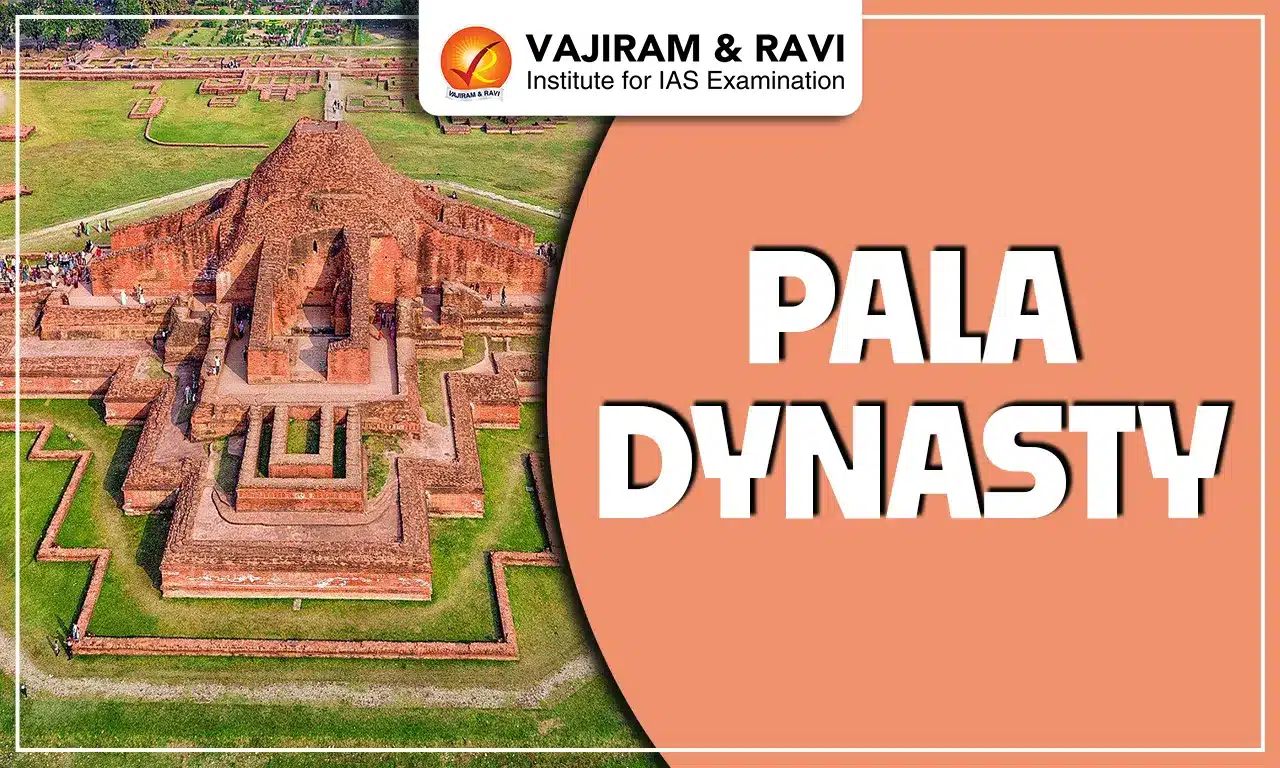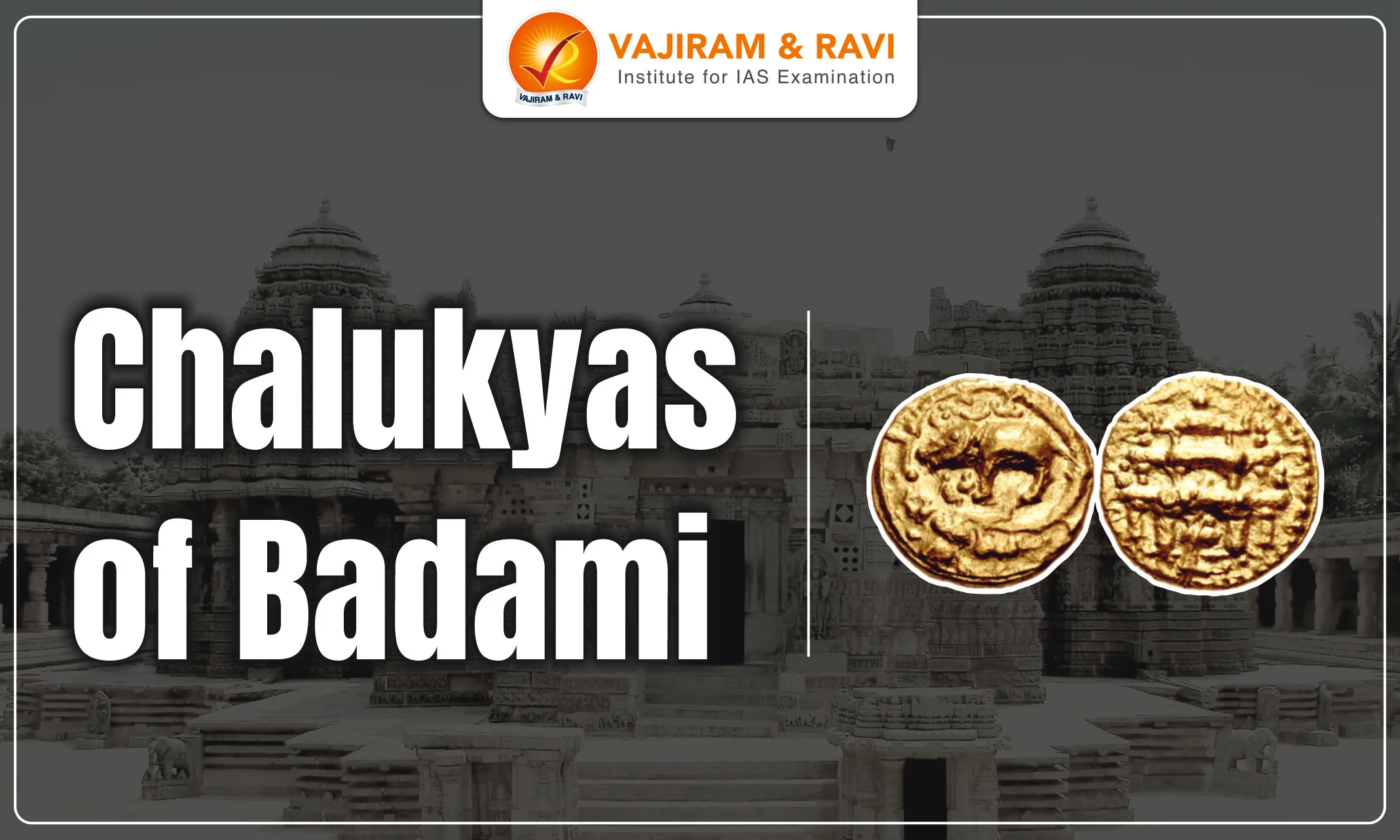Pala Dynasty Origin
After the death of Harsha, the Pratiharas (Jalore-Rajasthan), the Palas (Bengal) and the Rashtrakutas (Deccan) engaged in a tripartite struggle for the control of the Ganga–Yamuna doab and the lands adjoining it.
- Territories in Pala control: The Palas controlled vast areas of the eastern Gangetic Plain. Apart from earning revenue from agriculture, Palas also derived income from their wide commercial contacts in Southeast Asia.
- Accession to power by Gopala: There was no centralized government in place after the Gauda kingdom fell, which resulted in ongoing conflicts between minor chieftains. So, in the year 750 CE, a group of chiefs chose Gopala, a "Kshatriya chief," to be their leader.
- Political authority: Though Gopala did not have royal antecedents, he succeeded in acquiring a kingdom. Gopala’s political authority was soon recognised by several independent chiefs.
- His original kingdom was in Vanga. It was located in southern Bengal, with the core region including present-day southern West Bengal (India) and southwestern Bangladesh.
- Political authority: Though Gopala did not have royal antecedents, he succeeded in acquiring a kingdom. Gopala’s political authority was soon recognised by several independent chiefs.
Pala Dynasty Map
Pala Dynasty Rulers
| Pala Dynasty - Kings - Significance | |||||
| Period: 750-1150 AD | Capital: Muddagiri/Munger (Bihar) | ||||
| Ruler | Significance | ||||
| Gopala (750-770 CE) |
|
||||
|
Odantapuri Monastery, Odantapura |
|
||||
| Dharmapala (770-810 CE) |
Titles: He assumed titles like Paramesvara, Parambhattaraka and Maharajadhiraja.
|
||||
| Contribution to Architecture | |||||
|
Vikramashila Monastery, Bhagalpur |
|
||||
|
Somapra Vihara, Paharapura |
|
||||
| Devapala (810-850 CE) |
|
||||
| Mahipala I (988-1038 CE) |
|
||||
Pala Dynasty Art and Architecture
| Contribution of Palas to Art and Architecture | |||||
|
|||||
|
Sculpture of Vishu |
Vishnu with His Consorts, Lakshmi and Sarasvati, 11-12th century, Bihar or Bengal | ||||
|
Crowned Buddha |
|
||||
|
Nalanda University |
|
||||
Pala Dynasty Literature
| Contribution of Palas to Literature | |||||
|
|||||
| Author | Work | ||||
| Sandhyakar Nandi: |
|
||||
| Jimutavahana |
|
||||
| Bhatta Bhavadeva |
|
||||
| Sridhar Bhatta |
|
||||
| Gaudapada |
|
||||
| Chakrapani Datta |
|
||||
| Sureshwara |
|
||||
| Vangasena |
|
||||
| Gadadhara Vaidya |
|
||||
Pala Dynasty Administration
- Monarchical rule: The Pala rule was monarchical. The king was the centre of all imperial titles like Parameshwara, Paramvattaraka, and Maharajadhiraja. Pala kings appointed Prime Ministers.
- Lineage: The Line of Garga served as the Prime Ministers of the Palas for 100 years. They are Garga, Darvapani (or Darbhapani), Someshwar, Kedarmisra and Bhatta Guravmisra.
- Provincial administration: Pala Empire was divided into separate Bhuktis (Provinces). Bhuktis were divided into Vishayas (Divisions) and Mandalas (Districts).
- Smaller units were Khandala, Bhaga, Avritti, Chaturaka, and Pattaka. Administration covered a wide area from the grass root level to the imperial court.
Pala Dynasty Religion
Buddhism was the dominant religion during the Pala dynasty, but Shaivism also flourished and was followed alongside it.
Buddhism:
- Mahayana Buddhism: The Palas were patrons of Mahayana Buddhism. A few sources written much after Gopala's death mention him as a Buddhist, but it is not known if this is true. The subsequent Pala kings were Buddhists.
- Dharmapala: Dharmapala made the Buddhist philosopher Haribhadra his spiritual preceptor. Taranatha credits him with establishing 50 religious institutions and patronising the Buddhist author Haribhadra.
- Devapala’s contribution: He restored and enlarged the structures at Somapura Mahavihara, which also features several themes from the epics Ramayana and Mahabharata.
- Mahipala I: He also ordered the construction and repairs of several sacred structures at Saranath, Nalanda and Bodh Gaya.
- Buddhist centres: The Palas developed the Buddhist centres of learning, such as the Vikramashila and the Nalanda universities. Nalanda, considered one of the first great universities in recorded history, reached its height under the patronage of the Palas.
- Reputation: As the rulers of Gautama Buddha's land, the Palas acquired a great reputation in the Buddhist world as the kings of other regions approached them for permission to do any activity at Bodhgaya.
- Ambassadors: Balaputradeva, the Sailendra king of Java, sent an ambassador to him, asking for a grant of five villages for the construction of a monastery at Nalanda.
- The request was granted by Devapala. He appointed the Brahmin Viradeva as the head of the Nalanda monastery.
- Bengal as the centre of Buddhism: Bengal remained one of the few places where Buddhist monasteries continued to exist. The kingdom, as well as Buddhism, soon suffered a decline because of the large-scale conversion of merchants and artisans to Islam.
Shaivisim
- Patronage: The Palas continued to patronise Shaivism, and epigraphic evidence suggests that Mahipala I and Nayapala were initiated as Shaivites by their royal preceptors.
- Vigrahapala III: Vigrahapala III's Amagachi inscription describes him as "devoted to Siva worship", and this tradition continued under his successor Ramapala. Poet Sandhyakar Nandi describes Ramapala's son Madanapala as a devotee of Shiva
- Shaiva ascetics: The Palas supported the Saiva ascetics, typically the ones associated with the Golagi-Math. Besides the images of the Buddhist deities, the images of Vishnu, Siva and Sarasvati were also constructed during the Pala dynasty rule.
- Shaivite temples: Narayanapala's Bhagalpur inscription suggests that he built several Shiva temples and records his grant of a village to Pashupatas. Narayanapala also attended a sacrifice by his Brahmin minister.
- Land grants: Madanapala's queen Chitramatika, gifted land to a Brahmana named Vateshvara-Swamy Sharma as his remuneration for reciting the Mahabharata.
Pala Dynasty Decline
After 15 years of Mahipala’s rule, four insignificant rulers followed, and it proved fatal to the continuation of the dynasty.
- Last efforts: Ramapala was the last ruler who tried to recover the lost glory of the dynasty. He ruled for about 53 years, and after his death, the presence of the Pala dynasty was confined to only a portion of Mag
- adha (Bihar) and continued to exist only for a short period.
- Rise of powerful rivals: Vijayasena of the Sena dynasty, who had become powerful by then in northern Bengal, expelled the last ruler Madanapala from Bengal and established his dynastic rule.
Last updated on December, 2025
→ Check out the latest UPSC Syllabus 2026 here.
→ Join Vajiram & Ravi’s Interview Guidance Programme for expert help to crack your final UPSC stage.
→ UPSC Mains Result 2025 is now out.
→ UPSC Notification 2026 is scheduled to be released on January 14, 2026.
→ UPSC Calendar 2026 is released on 15th May, 2025.
→ The UPSC Vacancy 2025 were released 1129, out of which 979 were for UPSC CSE and remaining 150 are for UPSC IFoS.
→ UPSC Prelims 2026 will be conducted on 24th May, 2026 & UPSC Mains 2026 will be conducted on 21st August 2026.
→ The UPSC Selection Process is of 3 stages-Prelims, Mains and Interview.
→ UPSC Result 2024 is released with latest UPSC Marksheet 2024. Check Now!
→ UPSC Prelims Result 2025 is out now for the CSE held on 25 May 2025.
→ UPSC Toppers List 2024 is released now. Shakti Dubey is UPSC AIR 1 2024 Topper.
→ UPSC Prelims Question Paper 2025 and Unofficial Prelims Answer Key 2025 are available now.
→ UPSC Mains Question Paper 2025 is out for Essay, GS 1, 2, 3 & GS 4.
→ UPSC Mains Indian Language Question Paper 2025 is now out.
→ UPSC Mains Optional Question Paper 2025 is now out.
→ Also check Best IAS Coaching in Delhi
Pala Dynasty FAQs
Q1. What is Pashupata sector Shaivism?+
Q2. What are the features of the Pala school of Architecture?+
Tags: pala dynasty quest

















